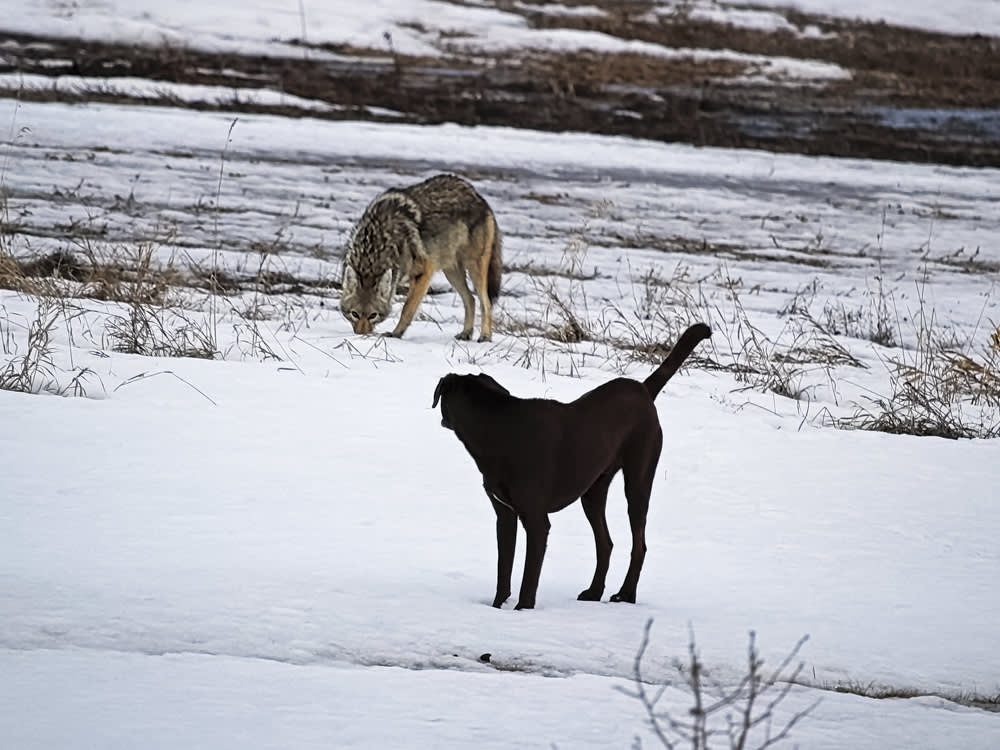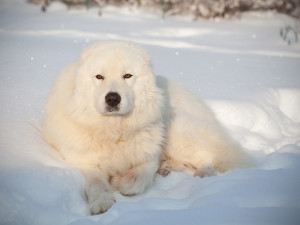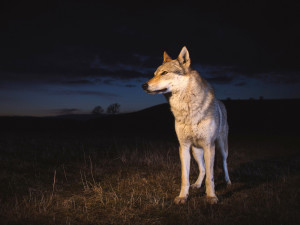What Happens When a Dog Meets a Coyote
The two animals are close relatives — but that doesn't mean they'll play nice.

Share Article
Whether you live in an urban, suburban, or rural area, coyotes can be a threat to your pet. Coyotes live all over North America, and their population continues to thrive. You may have heard of coyotes preying on house cats, but what about dogs? Should you be concerned that a coyote will attack your pup?
Most coyotes are fearful of people and generally make an effort to avoid us. They react very differently to dogs, however, taking quite an interest in them. Coyotes may view dogs as a threat, or as potential prey, depending mainly on the size of the dog.
Dogs and coyotes are close relatives, but how they behave around each other has not been well studied. In the past, it was difficult to observe interactions between dogs and coyotes, but social media has changed that. Recently, researchers interested in the nature of dog-coyote interactions used YouTube videos to explore how these two canids behave around one anotheropens in new tab. Here's what they found.
How Dogs and Coyotes Interact
The researchers in the study evaluated 35 clips of free ranging coyotes and dogs in spontaneous, unplanned interactions. There were 4 videos that captured coyotes behaving in a predatory way towards dogs, 11 videos that showed dogs and coyotes participating in social play, and 9 videos of the two species in agonistic interactions, which relates to fighting but is much broader than aggression because it also includes threats, retreats, displays, conciliatory behavior, and appeasement. Videos that did not show any of these categories of behavior were classified as other/undetermined.

The researchers found that members of both species directed playful behavior to members of the other species, leading to play bouts. The play behavior between the two species generally involved chasing behavior with reversals being common. Play bows were performed frequently in the play, sometimes by the dog, sometimes by the coyote, and in some cases, by both species during a play bout.
There were also videos in which dogs bit coyotes and one in which a coyote bit a dog. Additionally, in 3 videos, coyotes attacked and shook small dogs, all of whom escaped. In one case, the coyote dropped the dog and ran away when a larger dog ran towards and lunged at the coyote. There were no instances of dogs behaving in a predatory way toward coyotes.
The videos with behavior that was not classified included several instances of potential predatory interest in dogs by coyotes. In those videos, coyotes were watching small dogs from a distance but without engaging in any actual stalking or other hunting behavior. One video showed potential sexual interest by a coyote in a dog. The male coyote followed a female dog slowly and within 5 meters, stopping multiple times to sniff the ground and to urinate.
Variables That Could Be At Play
As you might expect, size is a factor in the types of interactions that dogs have with coyotes. In the videos evaluated for this study, dogs were classified as small, medium, or large. Dogs were larger than the coyotes in all but one agonistic interaction. Only one small dog had a playful interaction with a coyote, and coyotes only engaged in predatory shaking behavior with small dogs.
The materials for this study — opportunistically acquired videos that people were motivated to post — do have a sampling bias. With the exception of a few surveillance videos, they were taken when people were with their pets, generally during the day and mainly in well-populated areas.
Even with those concerns, the valuable takeaway from this study is that there are a number of ways in which dogs and coyotes interact. Future studies could be even more comprehensive if people are encouraged to film and submit footage of these species interacting together. But remember: Coyotes are dangerous, wild animals, so do not encourage your dog to interact with them. It's simply not safe.
Avoiding Confrontations with Coyotes
The best way to avoid trouble with a coyote is to avoid coyotes, sounds simple right? That isn’t always easy to do but here are a few tips:
Stay away from areas known to have a lot of coyotes.
Stick to open trails and paths and stay away from areas with thick vegetation.
Walk your dog on a leash.
Don’t walk in coyote-prone areas around sunrise or sunset.
If you do see a coyote, do not run away. Be assertive and attempt to scare the coyote away. In the spring it is possible that coyote pups are around, in that case, walk away rather than try to scare the coyote. Your dog will probably bark and make it tough but, do not turn your back on the coyote, always back up.

Karen B. London, PhD, CAAB, CPDT-KA
Karen B. London is a certified applied animal behaviorist (CAAB) and certified professional dog trainer (CPDT) who specializes in working with dogs with serious behavioral issues, including aggression. She has written for a variety of magazines including The Bark, Clean Run, and the APDT Chronicle of the Dog, and has published in scientific journals including Behavioral Ecology and Sociobiology, Ethology, Ecology, and Evolution, the Journal of Insect Behavior, and Insectes Sociaux. She is the author of seven books about dog training and canine behavior, including the forthcoming My Dog's Mystery Adventure: And Other Stories From a Canine Behaviorist and Dog Trainer.

